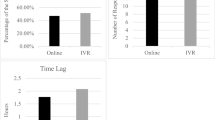Abstract
Recently, marketers have increased their research budgets and used many methods to capture the “voice of the customer”. Yet surveys, which are used regularly in marketing research, are still tainted by nonresponse rates despite efforts to reduce them. We study overnight delivery (OD) as a survey method for reducing nonresponse. Precontact, a commonly used survey practice, is also considered. Three primary results emerge: (1) overall, OD increases response rates, but increases response times; (2) similarly, precontact increases response rates, although it generates increased response times; and (3) OD combined with precontact provides the greatest rate of response.
Similar content being viewed by others
References
Assael, Henry, and John Keon (1982), “Nonsampling vs. Sampling Errors in Survey Research,” Journal of Marketing, 46 (spring), pp. 114–123.
Barabba, Vincent, and Gerald Zaltman (1991), Hearing the Voice of the Market: Competitive Advantage Through Creative Use of Market Information, Boston, MA: Harvard Business School Press.
Chapman, Randall G. (1988), “False Economies in Survey Research,” Applied Marketing Research, 28 (spring), pp. 16–20.
Delener, Nejdet (1995), “An Integrative Review of Nonresponsive Errors in Survey Research: Major Influences and Strategies,” Jagdish Sheth and Atul Parvatiyar, eds., Research in Marketing, vol. 12, pp. 49–80, Greenwich, CT: JAI Press.
Deming, W. Edwards (1960), Sample Design in Business Research, New York: John Wiley & Sons, Inc.
Dickson, John P., and Douglas L. MacLachlan (1996), “Fax Surveys: Return Patterns and Comparison with Mail Surveys,” Journal of Marketing Research, 33 (February), pp. 108–113.
Dillman, Don A. (1978), Mail and Telephone Surveys: The Total Design Method, New York: JohnWiley & Sons, Inc.
Edmonston, Jack (1997), “Why Response Rates are Declining,” Advertising Age' Business Marketing—Chicago, 82 (September), p. 12.
Erdos, Paul L. (1970), Professional Mail Surveys, New York: McGraw-Hill.
Fox, Richard J., Melvin R. Crask, and Jonghoon Kim (1989), “Mail Survey Response Rate: A Meta-Analysis of Selected Techniques for Inducing Response,” Public Opinion Quarterly, 52 (winter), pp. 467–491.
Granatstein, Lisa (1998), “A New Read on Readers,” Mediaweek, 8 (March 23), pp. 19–20.
Haggett, Sarah, and Vincent-Wayne Mitchell (1994), “Effect of Industrial Prenotification on Response Rate, Speed, Quality, Bias and Cost,” Industrial Marketing Management, 23 (April), pp. 101–111.
Heberlein, Thomas A., and Robert Baumgartner (1978), “Factors Affecting Response Rates to Mailed Questionnaires: A Quantitative Analysis of the Published Literature,” American Sociological Review, 43 (August), pp. 447–462.
Kosek, Chairman (1998), “Voicemail Hurts Survey Response Rates,” Advertising Age' Business Marketing— Chicago, 83 (April), p. 8.
Mehta, Raj, and Eugene Sivadas (1995), “Comparing Response Rates and Response Content in Mail versus Electronic Mail,” Journal of the Market Research Society, 37 (October), pp. 429–440.
Ratneshwar, Srinivasan, and David W. Stewart (1989), “Nonresponse in Mail Surveys: An Integrative Review,” Applied Marketing Research, 29 (summer), pp. 37–46.
Schlegelmilch, Bodo B., and Adamantios Diamantopoulos (1991), “Prenotification and Mail Survey Response Rates: A Quantitative Integration of the Literature,” Journal of the Market Research Society, 33 (July), pp. 243–255.
Sudman, Seymour, and Norman M. Bradburn (1974), Response Effects in Surveys: A Review and Synthesis, Chicago, IL: Aldine.
????, and Norbert Schwarz (1996), Thinking About Answers, The Application of Cognitive Processes to Survey Methodology, Chicago, IL: Aldine.
Author information
Authors and Affiliations
Rights and permissions
About this article
Cite this article
Silverman, S.N. Absolutely, Positively Hearing the Voice of the Customer: Exploring Overnight Delivery in Survey Research. Journal of Market-Focused Management 4, 143–159 (1999). https://doi.org/10.1023/A:1009895732670
Issue Date:
DOI: https://doi.org/10.1023/A:1009895732670




